#attachment
Explore tagged Tumblr posts
Text
Writing Notes: Anxious Attachment Style
Common Anxious Thoughts, Emotions, and Reactions
THOUGHTS
Mind reading: "That’s it, I know s/he’s leaving me."
All-or-nothing thinking: "I’ve ruined everything, there’s nothing I can do to mend the situation."
"I’ll never find anyone else."
"I knew this was too good to last."
"I have to talk to or see him/her right now."
"S/he can’t treat me this way! I’ll show him/her!"
"S/he is so amazing, why would s/he want to be with me anyway?"
"I knew something would go wrong; nothing ever works out right for me."
"S/he’d better come crawling back to beg my forgiveness, otherwise s/he can forget about me forever."
"Maybe if I look drop-dead gorgeous or act seductive, things will work out."
Remembering all the good things your partner ever did and said after calming down from a fight.
Recalling only the bad things your partner has ever done when you’re fighting.
EMOTIONS
Sad ⚜ Angry ⚜ Fearful ⚜ Resentful ⚜ Frustrated
Hopeless ⚜ Despairing ⚜ Jealous ⚜ Hostile ⚜ Vengeful
Guilty ⚜ Self-loathing ⚜ Restless ⚜ Uneasy ⚜ Humiliated
Hate-filled ⚜ Uncertain ⚜ Agitated ⚜ Rejected ⚜ Depressed
Unloved ⚜ Lonely ⚜ Misunderstood ⚜ Unappreciated
ACTIONS
Act out. ⚜ Attempt to reestablish contact at any cost.
Pick a fight. ⚜ Threaten to leave.
Wait for them to make the first reconciliation move.
Act hostile—roll eyes, look disdainful.
Try to make him/her feel jealous.
Act busy or unapproachable. ⚜ Act manipulatively.
Withdraw—stop talking to their partner or turn away from him/her physically.
Attachment classifications come from watching babies’ behavior.
Below is a short description of how anxious attachment style is defined in children. Some of their responses can also be detected in adults who share the same attachment style.
This baby becomes extremely distressed when mommy leaves the room.
When her mother returns, she reacts ambivalently—she is happy to see her but angry at the same time.
She takes longer to calm down, and even when she does, it is only temporary.
A few seconds later, she’ll angrily push mommy away, wriggle down, and burst into tears again.
Where Do Attachments Styles Come From?
Initially it was assumed that adult attachment styles were primarily a product of your upbringing.
Thus, it was hypothesized that your current attachment style is determined by the way in which you were cared for as a baby:
If your parents were sensitive, available, and responsive, you should have a secure attachment style; if they were inconsistently responsive, you should develop an anxious attachment style; and if they were distant, rigid, and unresponsive, you should develop an avoidant attachment style.
Today, however, we know that attachment styles in adulthood are influenced by a variety of factors, one of which is the way our parents cared for us, but other factors also come into play, including our genes and life experiences.
Source ⚜ More: On Attachment ⚜ Writing Notes & References Writing Resources PDFs ⚜ Avoidant ⚜ Secure ⚜ Disorganized
#requested#writing reference#attachment#psychology#writeblr#writing notes#studyblr#literature#writers on tumblr#dark academia#spilled ink#writing prompt#light academia#fiction#anxious attachment#writing resources
2K notes
·
View notes
Text
Transparent LED Screen transforming windows or glass into a dynamic video screen.
7K notes
·
View notes
Text
Disney, hire me as your Attachment Advisor, I will shove so many George Lucas quotes at your producers and writers, I will shove so many context-laden clips from the movies and TCW at your creatives, I will make powerpoint essays about how it's more Buddhist-aligned, not Attachment Theory-aligned, I will cite literally every time attachment has ever been discussed by Lucas AND in the show itself and show you that it's always aligned with fear, possessive feelings, and selfishness, I will do this work for you for free, I can even literally just point you to my Jedi Citations collection, DISNEY, HIRE ME AS YOUR ATTACHMENT ADVISOR, I CAN HELP YOU.
#lumi.txt#star wars#the acolyte#the acolyte spoilers#attachment#sw negativity#i guess? it's not that bad but you know#i make myself laugh and that's all that's important
1K notes
·
View notes
Text
Debunking myths in the GFFA: Luke Skywalker isn't the One True Jedi™ and doesn't "reject the Jedi teachings."
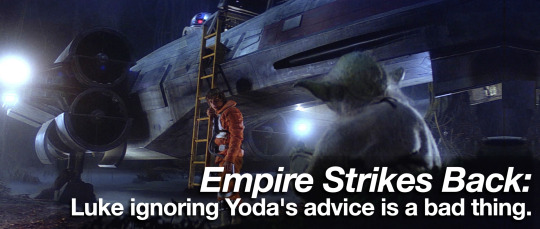
The myth:
Luke's Jedi mentors - trained to be dispassionate and mission-driven - callously tell him to let his friends die in service of a greater cause.
"In The Empire Strikes Back, Luke becomes Yoda's Padawan, and there are echoes of Anakin's training and the dilemmas he faced. Like Anakin, Luke is told he is too old to begin the training. Like Anakin, he has a vision of his loved ones suffering in captivity, and receives cold advice from Yoda, who tells him to sacrifice Han and Leia if he honors what they fight for." - Jason Fry, “Family Tradition; Rejecting the Jedi Teachings” Star Wars Insider #130, 2012

The intended narrative:
The Jedi are actually right on all points. Luke isn't ready or fully trained and he's arrogantly letting his emotions rule him and rushing into danger. By ignoring them, Luke gets himself into a spot of trouble that actually jeopardizes the lives of the very friends he tried to help, as they now need to rescue him.
“It’s pivotal that Luke doesn’t have patience. He doesn’t want to finish his training. He’s being succumbed by his emotional feelings for his friends rather than the practical feelings of “I’ve got to get this job done before I can actually save them. I can’t save them, really.” But he sort of takes the easy route, the arrogant route, the emotional but least practical route, which is to say, “I’m just going to go off and do this without thinking too much.” And the result is that he fails and doesn’t do well for Han Solo or himself.”
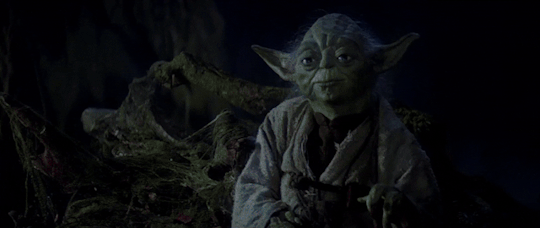
“Luke is making a critical mistake in his life of going after- to try to save his friends when he’s not ready. There’s a lot being taught here about patience and about waiting for the right moment to do whatever you’re going to do.”
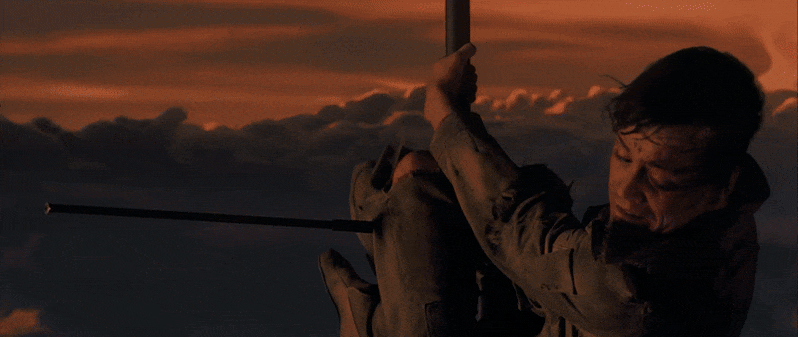
“Luke is in the process of going into an extremely dangerous situation out of his compassion— Without the proper training, without the proper thought, without the proper foresight to figure out how he’s gonna get out of it. His impulses are right, but his methodology is wrong.”
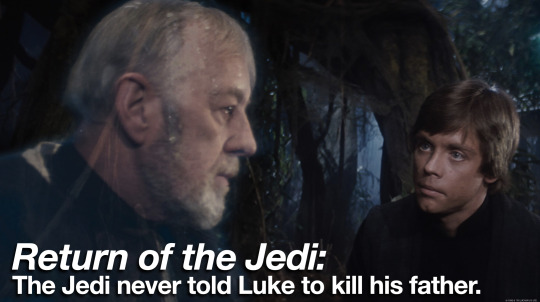
The myth:
The Jedi want Luke to repress his feelings and kill his father, to destroy the Sith, their religious enemies. As emotionally-detached Jedi, it is inconceivable that a Sith would come back from the Dark Side, and thus wrongly believe that the only solution is to kill Vader.
"It's easy to miss that Luke disagrees sharply with his Jedi teachers about what to do. Obi-Wan and Yoda have trained Luke and push him toward a second confrontation with Vader. He is, they believe, the Jedi weapon that will destroy both Vader and the Emperor. When Luke insists there is still good in Vader, Obi-Wan retorts that "he's more machine than man-twisted and evil." When Luke says he can't kill his own father, Obi-Wan despairs, "Then the Emperor has already won." But Obi-Wan could not be more wrong. It is precisely because Luke can't kill his own father that he defeats the Sith." - Jason Fry, Star Wars Insider #130, 2012

The intended narrative:
The Jedi never tell Luke to "kill" his father. That's just a fact.
They tell him to "confront" and "face" him.
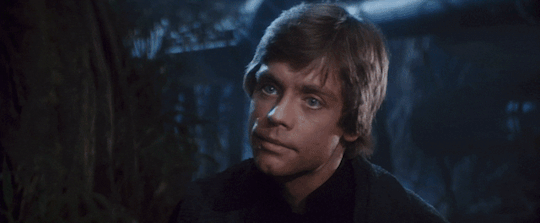
Their bottom line is that Vader and the Emperor need to be stopped.
If Luke can manage to do so without killing his father, that's great.
"In Jedi the film is really about the redemption of this fallen angel. Ben is the fitting good angel, and Vader is the bad angel who started off good. All these years Ben has been waiting for Luke to come of age so that he can become a Jedi and redeem his father. That's what Ben has been doing, but you don't know this in the first film." - Star Wars: The Annotated Screenplays, 1998
(credit to @writerbuddha for finding the above quote)
The problem is: Darth Vader has a track record of murdering loved ones who refuse to kill him. Be it his wife...
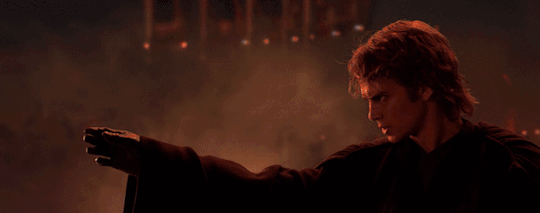
... his father/brother...
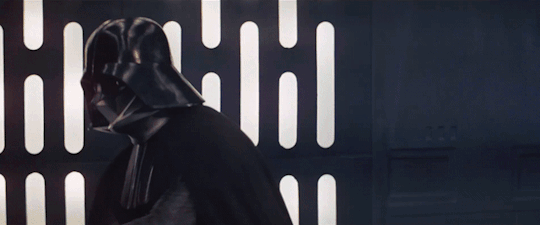
... and if you're going by Canon, his little sister.
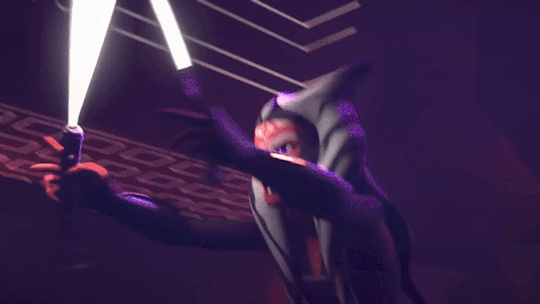
As such, there's a very strong chance that Vader might do the same to his son as well.
“A Jedi can’t kill for the sake of killing. The mission isn’t for Luke to go out and kill his father and get rid of him. The issue is, if he confronts his father again, he may, in defending himself, have to kill him, because his father will try to kill him.” - 1981 story conference, from The Making of Return of the Jedi
Now, as the last Jedi left, the fate of the galaxy rests entirely on Luke's shoulders.
If he dies, then the galaxy and its billions of inhabitants are doomed to live in a tyrannical dictatorship forever.
“He knows a confrontation is brewing between Luke and his father. Ben hopes Luke will either save his father or kill him, because whatever extra powers Luke's got in his lineage, he is the one person that can probably fight his father and win.” - The Star Wars Archives: 1977-1983, 2018
There's a time for talking things through... and a time to do your duty. Above all else, a Jedi's duty is to end conflict.
Obi-Wan was once tasked with this same duty.
And while he managed to weaken Vader considerably (thus avoiding the catastrophe of a full-powered Vader being unleashed onto the galaxy)... because of his attachment, he failed to kill Vader.
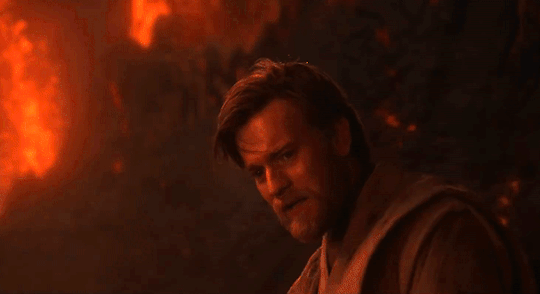
Twice, if you include the Kenobi show.
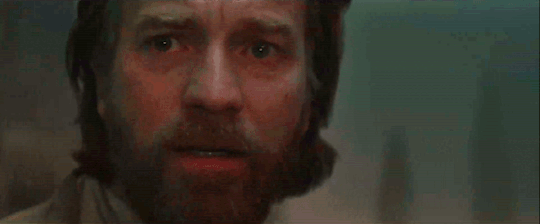
(A show which, per Pablo Hidalgo, is one of George Lucas' favorite recent Star Wars projects, a tidbit that doesn't surprise me one bit considering how much the series perfectly aligns with what Lucas said about Star Wars (see here, here and here))
Point being: because Ben failed his duty, the galaxy suffered for it.
Luke is now in danger of doing the same.
If he's unable to end the conflict in a peaceful way, then Luke needs to be ready to do so in a more permanent manner. Because while Luke has qualms about killing his father, there's a very big chance that the feeling won't be mutual.
So Luke isn't rejecting his teachers' orders to kill Vader. He's saying he's unable to confront Vader altogether, because he'll be half-assing the task. In the (very likely) worst case scenario where reasoning with Vader fails, Luke is concerned he won't be able to follow-through and do what he must.
Further, there's also a worse outcome to Luke dying: Luke joining the Dark Side and becoming yet another asset of the Emperor, more dangerous than Vader himself.
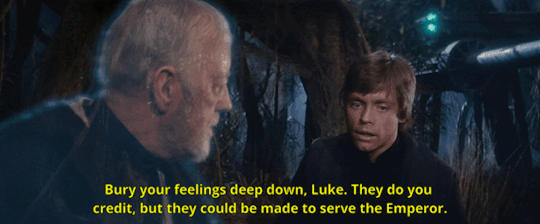
It's thus essential that Luke steel himself and mask his emotions, because the Emperor is a master manipulator who'll likely attempt to corrupt Luke via the strong emotions he has for his friends.
Obi-Wan is not telling Luke to repress his emotions. On the contrary, he acknowledges that these feelings do Luke credit. But the fact remains that when your opponent can jiu-jitsu those feelings against you and your friends, you need to keep a poker face.
And judging by how close the Sith Lords come to seducing Luke to the Dark Side...
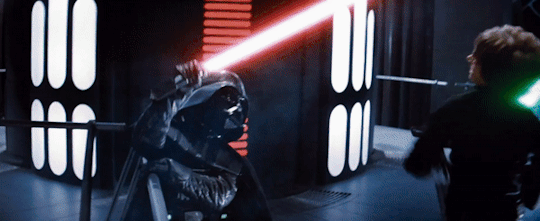
... that advice is completely on point.
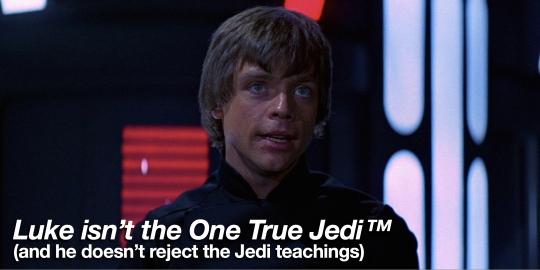
The myth:
"It isn't Jedi teachings that save the galaxy, but bonds the Jedi tried to forbid - such as the love of a father for his son, and a son for his father. Emotional attachments, in other words." - Jason Fry, Star Wars Insider #130, 2012

The intended narrative:
In Return of the Jedi, Luke isn't doing anything different than what other Jedi have done.
He does his best to avoid lethal force unless he deems that it is necessary (see his fight against Jabba's hostile forces).
He sacrifices himself for the greater good and let himself be captured, in order to allow the mission to be carried out.
He tries to reason with his enemy, hoping to avoid conflict.
He spares his enemy, showing mercy.
That's all standard Jedi stuff. We've seen other Jedi do all those things, both in the films and The Clone Wars.
If that isn't enough, just look at how Lucas describes what Jedi normally do (left), versus what Luke does in Return of the Jedi (right):
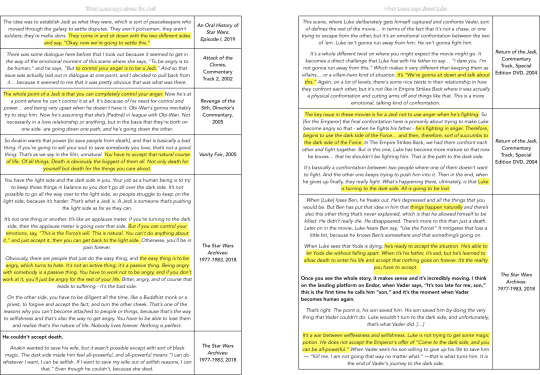
See what I mean? There’s pretty much no difference.
In Lucas' narrative, Luke isn’t “better than” or “rejecting the teachings” of the Jedi who came before him. He’s following the Jedi path. And he's really good at doing so.
Because this idea that Luke "rejects the teachings" makes no sense! They're Lucas' teachings. He agrees with the Jedi, they're the mouthpieces he uses to deliver the audience his own values.
Lucas having his main character do something he'd ideologically disagree with is something that doesn't make sense.
And part of this confusion comes from a misunderstanding of the word "attachment", in Star Wars.
It doesn't mean "emotional attachments" or "feelings" or "affection." It comes from the Buddhist principle of non-attachment.
It's not about depriving yourself of relationships or affection, it's about accepting that everything comes and goes and letting go of those very things you hold on to, when the time comes.
Lucas makes a distinction in his discourse between attachment and compassion.
"The whole idea of the movie, ultimately is that you have the Light Side and the Dark Side. The Light Side is compassion, which means you care about other people. The Dark Side is you care only about yourself. And you are obsessed with yourself. Getting your pleasure and getting all your stuff. The other one, you give it to everybody. You give goodness and health to everybody else. So the issue of love... there’s a line between loving somebody compassionately and caring about them and helping them. But the other line is not to be greedy or... once you are greedy then you get fearful. You don’t want to lose what it is you have that you are getting. So you have to learn to give up everything. And ultimately for a Jedi Knight, it’s very easy to give up." - Celebration V, Main Event, 2010
In-universe, this is something Anakin knew the theory of, but never really applied all that much.

Luke on the other hand, was able to learn the lesson and apply it.
Speaking in Lucas lingo, it's not Luke's attachment that makes him spare Vader. It's his compassion. And in turn, that compassion inspires Vader to do the same.
"It really has to do with learning. Children teach you compassion. They teach you to love unconditionally. Anakin can’t be redeemed for all the pain and suffering he’s caused. He doesn’t right the wrongs, but he stops the horror. The end of the Saga is simply Anakin saying, ‘I care about this person, regardless of what it means to me. I will throw away everything that I have, everything that I have grown to love - primarily the Emperor - and throw away my life, to save this person. And I’m doing this because he has faith in me, loves me despite all the horrible things I’ve done. I broke his mother’s heart, but he still cares about me, and I can’t let that die.’" - The Making of Revenge of The Sith; page 221
Or, to put things more simply:
Attachment (selfish love), is what makes Anakin do this:
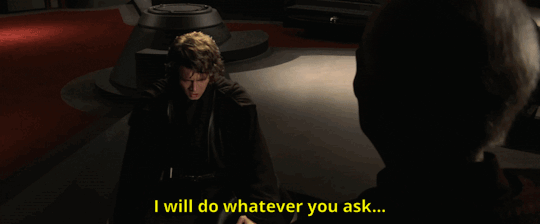

Compassion (selfless love), is what makes Luke do this:
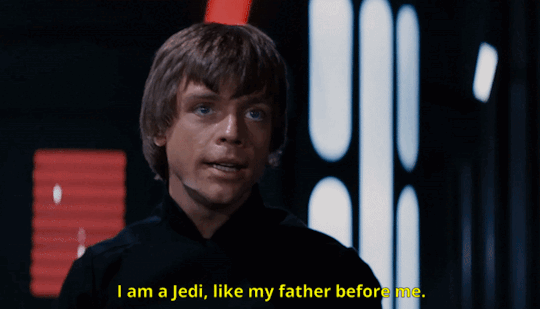
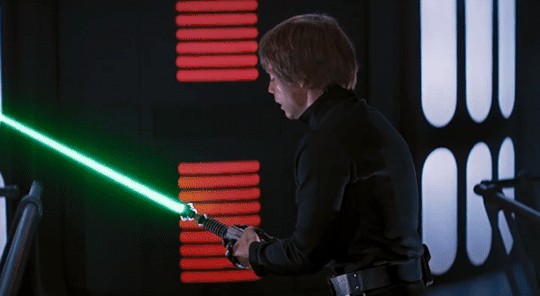
Now, could Lucas have made his narrative more explicit, to avoid confusion? Maybe.
But I think it's also fair to point the finger at the biggest cause of these muddied waters:
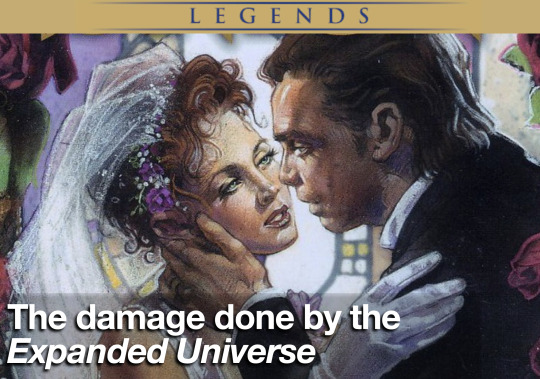
Simply put, the Expanded Universe (the Star Wars books, novels and games that spun out of the films) established new lore elements that didn't necessarily align with Lucas' vision of things. Namely:
Jedi can get married, and Luke marries Mara Jade.
Jedi can begin their training as adults, and Luke takes on many apprentices that are already adults.
When considering George's minimal involvement in the development of EU stories, it's easy to see why these plot points were allowed to come through.
But when he made the Prequels, his headcanons came to light and the above plot points needed to be retconned.

George Lucas' narrative:
"Nope. You can't be a Jedi and be married."
This isn't actually coming out of left field.
When Timothy Zahn asked for Luke and Mara to be married or engaged, back in 1993, Lucasfilm initially vetoed the idea.
And over the years, Lucas and other Lucasfilm employees have made it it clear that "Luke getting married" did not align with his vision (so much so that it's a plot point in Attack of the Clones).
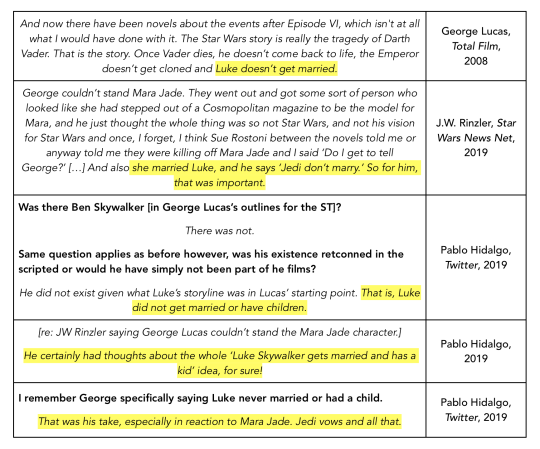
So the question becomes: why can't Jedi get married?
It's about commitment.
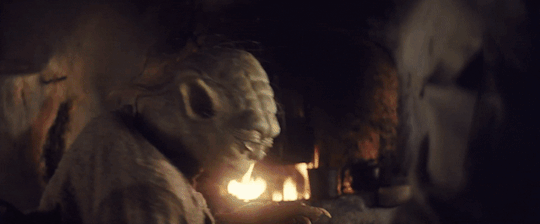
Simply put: you can't have two marriages. Eventually, your commitment to one of them will falter and you'll ruin them both. A Jedi is already married to the cause and to the Order.
If they want to get married, they have to leave the Jedi.
"One of the things [the Jedi] give up is marriage. They can still love people. But they can’t possess them. They can’t own them. They can’t demand that they do things. They have to be able to accept the fact, one, their mortality, that they are going to die. And not worry about it. That the loved ones they have, everything they love is going to die and they can’t do anything about it. I mean they can protect them as you would ordinarily protect, you know, ‘Get out of the way of that car.’ Somebody charges you with a gun, you knock the gun out, but there is an inevitability to life which is death and you have to accept that." - Celebration V, Main Event, 2010
And this is another example, really, of how Lucas' own values and past experiences shape the Jedi's teachings.
Marcia Lucas divorced George because he was constantly working on Star Wars, even when he wasn't directing it, which she said led to an emotional blockage in their marriage...
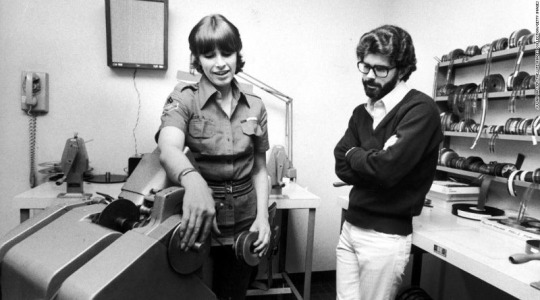
... and this leads us to the reason why George didn't double-down on the success of the Original Trilogy: he decided to take time off to raise his three kids as a single Dad.
He learned his lesson, reasoned that he wouldn't be able to be both a good, present father and a successful blockbuster film director.
When you're dealing with time-consuming commitments of this scale, you need to make a choice, or you'll end up (half-assing and thus ruining) both of them.
"Nope. Jedi get taken in as babies for a reason."
Once again, this has to do with Lucas' definition of "attachment."
"Jedi Knights get taken from their families very young. They do not grow attachments, because attachment is a path to the Dark Side. You can love people, but you can't want to possess them. They're not yours. Accept that they have a fate. Even those you love most are going to die. You can't do anything about that. Protect them with your lightsaber, but if they die they were going to die. There's nothing you can do. All you can do is accept that fact. In mythology, if you go to Hades to get them back, you're not doing it for them, you're doing it for yourself. You're doing it because you don't want to give them up. You're afraid to be without them. The key to the Dark Side is fear. You must be clean of fear, and fear of loss is the greatest fear. If you're set up for fear of loss, you will do anything to keep that loss from happening, and you're going to end up in the Dark Side. That's the basic premise of Star Wars and the Jedi, and how it works. That's why they're taken at a young age to be trained. They cannot get themselves killed trying to save their best buddy when it's a hopeless exercise." - The Star Wars Archives: 1977-1983, 2018
Jedi need to maintain objectivity and neutrality, in their day-to-day lives of mediating peace between planets.
And learning to "let go of your attachments when the time comes" is part of that training. But it is something that takes discipline and time, and thus the child needs to be young enough to develop this skill. Otherwise, they end up like Anakin, who always struggled to properly learn it and eventually was doomed by his greed.
This being part of Lucas narrative is also evidenced that in his earlier plans for the Sequel trilogy, he'd have Luke train children, not adults like he does in the EU.
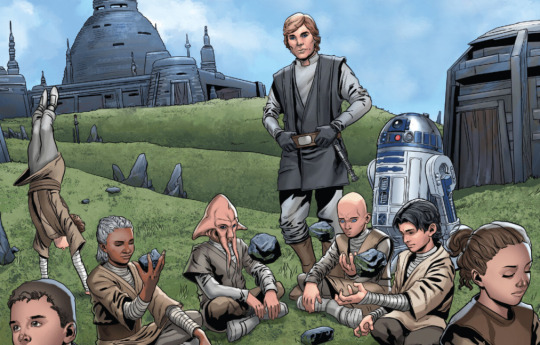
"Luke is trying to restart the Jedi. He puts the word out, so out of 100,000 Jedi, maybe 50 or 100 are left. The Jedi have to grow again from scratch, so Luke has to find two- and three-year-olds, and train them. It’ll be 20 years before you have a new generation of Jedi." The Star Wars Archives: 1999-2005, 2020

The EU's retcons of Lucas' narrative:
Now, obviously, the addition of all these rules and other elements such as midi-chlorians... it does something to the older audience. They grew up on the Original Trilogy, dreaming they could be a Jedi too if they just believed enough. Now that bubble is burst.
"Wait, if I'm a Jedi I can't get married?! And I need to be taken in as a toddler, with a certain kind of blood score?! That's bullshit!"
More importantly... it goes against about a decade's worth of established EU lore (which Lucas never factored into his storytelling)!
So what does Lucasfilm Licensing do? They go with it.
They take these "weird" rules the older audience and authors don't like, and retcon a new narrative around them to ensure both the books and the new films all stay canon within the EU own continuity.
George Lucas revealed new information about his universe in Episode II that ran counter to earlier stories of the Expanded Universe. Among the surprises: the Jedi Order is monastic, with love and marriage forbidden to its members. This would necessitate reforms to the Jedi Code over time to separate the ancient era when Nomi Sunrider was married to a Jedi, seen in the Tales of the Jedi (1993–94) comics, as well as the post-Empire era when Luke Skywalker married Mara Jade in the comic series Union (1999–2000). LucasBooks also needed to create plausible exceptions for Ki-Adi-Mundi, a Jedi Master who had multiple wives in the Prelude to Rebellion comics (1999). - Pablo Hidalgo, The Essential Reader’s Companion, 2012
When it comes to Luke specifically, the narrative becomes:

"Uh... y-yes. The old Jedi Order forbid marriage, only took in toddlers and had a blood pre-requisite... which was weird, wrong, too detached, too systemic, and part of why their Order failed! But, uh, Luke's New Jedi Order allows marriage, unlike his dogmatic predecessors, because anyone can be a Jedi guys!" Hahaha! (fuck's sake George)
But as already explained above: those new rules aren't meant to be perceived negatively. It would make no sense if they were, they're based on Lucas' own values.
You know what it does do, though?
It cements the narrative that Luke is the One True Jedi™, who rejected the dogmatic teachings to forge a new path forward.
That's not the intended narrative of the Original Trilogy, nor the six-film saga as a whole.
If you've made it this far in the post (congratulations) and are interested to read another all-encompassing post about that, you can check out the link below :)
#long post#REALLY long post#meta#luke skywalker#anakin skywalker#ben kenobi#star wars#george lucas#jedi order#yoda#jedi#empire strikes back#return of the jedi#the empire strikes back#original trilogy#tesb#ESB#ROTJ#star wars rotj#sw rotj#darth vader#sam witwer#dave filoni#attachment
806 notes
·
View notes
Text
I killed a part of me to keep you alive.
And u never noticed
#borderline personality disorder#bpd#mental illness#borderline culture is#bpd safe#bpd splitting#bpd thoughts#depressing shit#actually borderline#attachment#alive#survivor#notice#leave me alone
1K notes
·
View notes
Text
Absolutely wild to see Ezra Bridger circa season 1 described as someone who has "mastered the art of zero attachments" despite being like... nearly consumed by his fear of loss and abandonment and going on a wholeass journey throughout all four seasons towards figuring out how to trust again and how to understand that someone making a sacrifice isn't necessarily the same thing as being abandoned, that sacrifice can be an act of love as much as anything else, and it is THIS EXACT UNDERSTANDING of how to let go of his fear of losing those he loves that allows him to truly become a Jedi and understand what being a Jedi has always meant.
Like, gee, I'm sorry, but I dunno what you thought all of those blatantly obvious parallels to ANAKIN FUCKING SKYWALKER were all about other than showing that Ezra had learned to OVERCOME his attachments in a way Anakin did not, that Ezra was choosing to be the Jedi that Anakin should've been when faced with the exact same tests and temptations.
Rebels is not about realizing one should have more attachments because that's what saves you. It's about learning to LET GO of your attachments and accept change when it happens and to love people and love the world ANYWAY, even if you could lose them, even if you DO lose them, because THAT'S what will save you.
#star wars#star wars rebels#ezra bridger#attachment#attachment does not equal love#ffs this is the most Off interpretation of ezra bridger i might have ever seen
305 notes
·
View notes
Text
We ask your questions so you don’t have to! Submit your questions to have them posted anonymously as polls.
#polls#incognito polls#anonymous#tumblr polls#tumblr users#questions#polls about relationships#submitted june 8#attachment styles#attachment#emotions#relationships
452 notes
·
View notes
Text

#wisdom#wise#quotes#quote#fav#quote of the day#inspo#inspiration#motivation#discipline#attachment#yogi#balance#scale#worldly wisdom#nature#natural laws#cause and effect
210 notes
·
View notes
Text
Attachment is not a joke. losing your favorite person can mentally destroy you.
#love#life#relationship#friendship#mental health#feelings#attachment#love quotes#life quotes#daily quotes#thoughts#lines#literature#writing inspiration#writers on tumblr#qoutes#quotes#post on tumblr#quote#beautiful words
717 notes
·
View notes
Text

#oldermen#age gap relationships#tumblr girls#lana del rey#relationships#attachment#teacher crush#teacher attachment#aesthetic#girl blogger#this is what makes us girls#girlblogging#girlhood#hell is a teenage girl#just girly things
293 notes
·
View notes
Text
Writing Notes: Secure Attachment Style
Examples of Secure Principles
Be available ⚜ Don’t interfere ⚜ Act encouragingly
Communicate effectively ⚜ Don’t play games
View yourself as responsible for your partner’s well-being
Wear your heart on your sleeve—be courageous and honest in your interactions
Maintain focus on the problem at hand
Don’t make generalizations during conflict
Douse the flame before it becomes a forest fire—attend to your partner’s upsets before they escalate
How to Make Secure Principles Work
Try to keep a number of truths in mind when you are in the midst of a fight:
A single fight is not a relationship breaker
Express your fears! Don’t let them dictate your actions. If you’re afraid that s/he wants to reject you, say so.
Don’t assume you are to blame for your partner’s bad mood. It is most likely not because of you.
Trust that your partner will be caring and responsive and go ahead and express your needs.
Don’t expect your partner to know what you’re thinking. If you haven’t told him/her what’s on your mind, s/he doesn’t know!
Don’t assume that you understand what your partner means. When in doubt, ask.
A general word of advice: It’s always more effective to assume the best in conflict situations.
In fact, expecting the worst—which is typical of people with insecure attachment styles—often acts as a self-fulfilling prophecy.
If you assume your partner will act hurtfully or reject you, you automatically respond defensively—thus starting a vicious cycle of negativity.
Though you may have to talk yourself into believing the “positive truths” above (even if only halfheartedly at first), it is well worth the effort.
In most cases, they will steer the dialogue in the right direction.
Attachment classifications come from watching babies’ behavior.
Below is a short description of how secure attachment style is defined in children. Some of their responses can also be detected in adults who share the same attachment style.
The secure baby is visibly distressed when mommy leaves the room.
When mother returns, he is very happy and eager to greet her.
Once in the safety of her presence, he is quick to be reassured, calm down, and resume play activity.
Every person deserves to experience the benefits of a secure bond.
When our partner acts as our secure base and emotional anchor, we derive strength and encouragement to go out into the world and make the most of ourselves.
They are there to help us become the best person we can be, as we are for them.
Don’t Lose Sight of These Facts:
Your attachment needs are legitimate.
You shouldn’t feel bad for depending on the person you are closest to—it is part of your genetic makeup.
A relationship, from an attachment perspective, should make you feel more self-confident and give you peace of mind. If it doesn’t, this is a wake-up call!
And above all, remain true to your authentic self—playing games will only distance you from your ultimate goal of finding true happiness, be it with your current partner or with someone else.
Source ⚜ More: On Attachment ⚜ References ⚜ Avoidant ⚜ Anxious
#requested#writing reference#attachment#psychology#writeblr#writing notes#studyblr#literature#writers on tumblr#dark academia#spilled ink#writing prompt#light academia#fiction#secure attachment#writing resources
286 notes
·
View notes
Text
OK, I may have said this before, but I’m going to reiterate this point. Attachments aren’t what people seem to think they are.
Let me explain. In Star Wars, when the Jedi referred to attachment, they are referring to what Buddhism would refer to as in a literal translation an obsession. Attachments is the most closest western equivalent to the direct translation. And these attachments are basically the cause of suffering. Why? Because they prevent you from spiritual enlightenment. These aren’t things like family and friends. These are unhealthy obsessions that crippled you and make you unable to progress spiritually.
And the other inspiration for the Jedi Christianity has a similar explanation, although with a different theological implication, but the general principle is the same. In Christianity there is the idea that this world is transient. It’s not permanent nor are Christians supposed to get attached to it. The idea is is that they live in this world, but they are not of this world. That is not to say you can’t enjoy the things of this world like going out to the movies or having a good meal or spending time with friends and family. But it’s being aware that at any time it can go away. Either through misfortune, such as poverty or even death. Clinging onto the attachment of this world leads to spiritual ruin because you cease to focus on the supernatural such their relationship with God and how it affects their relationships with others and focusing on the superficial and harmful things. Again, it’s similar to Buddhism, but their solution is slightly different than Buddhism.
And that’s where Jedi get the principle of non-attachment. From the Buddhist idea of unhealthy obsessions lead to not spiritual enlightenment. And the Christian sense of focusing on the material world interferes with the relationship with the Creator. That’s why I don’t get why certain people seem to think that “attachments are good.” They’re basically saying, unnatural obsessions that lead you away from spiritual enlightenment, or a relationship with the creator of the universe, and the terms of the Jedi is somehow good. It’s not see Anakin Skywalker for how well that works out.
#star wars#pro jedi#pro jedi culture#love is not attachment#attachment does not equal love#attachment#pro jedi code
148 notes
·
View notes
Text
One thing that was really good about episode 4 of Ahsoka is that it knew exactly what the theme needed to be, the same thing that it always comes back to in Star Wars: Attachment. Ahsoka starts the episode off by saying that, if they can't get to the map, they may need to destroy it, stranding Ezra, because letting Thrawn come back is worse, knowing what would happen. Sabine's big temptation in this episode is exactly that--Baylan promises her that she can see Ezra again, because she thinks he's the only family he has left that she can do anything for, because she's so afraid to live without something that she makes a deal with the dark side. It's the exact same situation that Ezra had to make at the end of Rebels--he could bring Kanan back, but it would mean destroying all that Kanan saved in that moment, possibly even tear open time itself. He could have brought his parents back, but it would have let Sidious into the World Between Worlds to tear everything down. Which was the exact same situation that Anakin faced, that Ezra's was a riff off Anakin's, the willingness to trade the entire galaxy's freedom and lives for the one person (who wasn't even actually dead, either!) he was too afraid to live without. Which was the exact same situation that Luke faced, that he could save his friends if he would just give in to the dark side. It's the recurring theme of Star Wars, to face what attachment means to the Jedi, who are based on Buddhist monks, that attachment means the fear that makes you cling to someone or something so hard that you only end up hurting yourself--and Sabine, in her Jedi training, has to face this choice and she couldn't do it, she couldn't be selfless enough to let go and we can see it's going to be a shitshow. It's such a human, empathizable choice, she lost so much, her family is dead, she thinks Ahsoka is dead, she's been stagnating since Ezra left, she feels lost and adrift, of course she makes the wrong choice, of course she gives in to the fear that is attachment, and of course it's going to be awful. OUR GIRL IS GOING THROUGH IT, PLEASE BE KIND TO HER!!!!
2K notes
·
View notes
Text
Damian Desmond: An Attachment Perspective
**Spoilers for SxF Chapter 106 Below**
I loved this chapter for so many reasons, but the one I really want to highlight today is that Damian may be insecurely attached, but he still has hope. And that he is so brave, in his own way.
Exhibit A: When Damian knocks on Demetrius' door and asks for help, I am 100% positive that Damian wasn't truly expecting a response from Demetrius. He's used to being ignored, especially by his own family.
But he tried anyway.

This is important, because most children of Damian's age who fall under the category of avoidant attachment wouldn't approach a situation like this where there is a possibility that they would be rejected. It speaks volumes to me that Damian has a sense that he would be turned away, but still he tries.
"I was hoping..."
Exhibit B: There is also this moment where we see that Damian wanted to say something, and then he silences himself before he can say anything.
(Don't cry, Lass, omg dont cry 😭😭😭 )
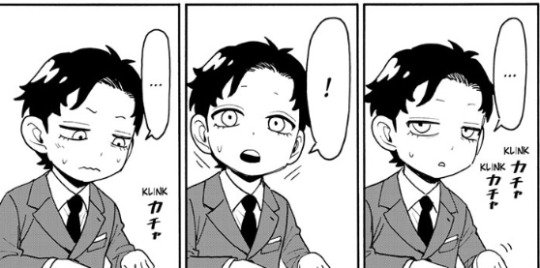
Damian is initially afraid, so he silences himself, but then there is this moment, where he pulls himself together, and tries again.
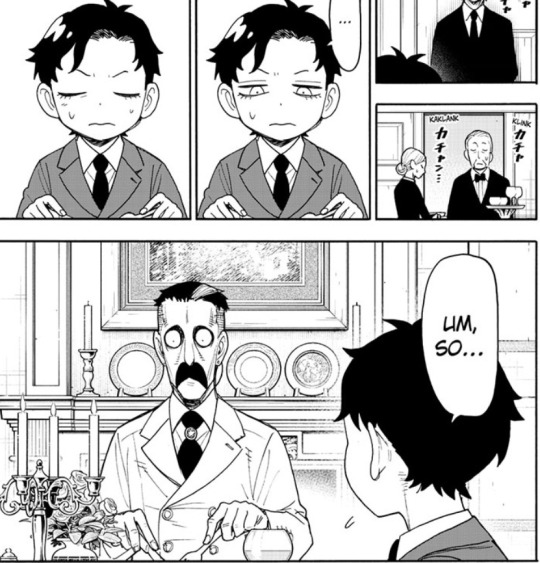
Endo is so brilliant at drawing out moments of important decisions for characters. You can see Damian making the decision to say something, and gather his courage, but he only falls short once he actually succeeds at getting Donovan's attention.
Under the heavy gaze of the head of the Desmond dynasty, I'm not surprised that 6-year old Damian felt his resolve crumble.
But!
He reverts to another option: find support. Which leads me to...
Exhibit C: This one makes me sob, actually. In response to his wavering confidence, Damian looks to his mother for support. The woman who should be his primary caregiver, and therefore his primary attachment figure.

And she turns away.
(Tears, tears down my face, my boy doesn't deserve this 😭 )
This is the third moment in this chapter alone that Damian does something that no other Desmond would dare: he seeks connection.
Damian tried to connect with his brother, his father, and his mother, all in the same chapter. He is the sole character that links them all.
All through Chapter 106, these are the moments that stood out to me the most, because it truly shows to me that Damian still has hope. Demetrius and Melinda are very clearly ingrained in their roles, and their behaviour is crystallised into what we see as the reader. It's obvious that this isn't the first time that Demetrius has rebuffed Damian's requests; and this isn't the first time that Melinda has ignored Damian's emotional needs.
I hear you wondering: Does Damian still have hope because he's still just a child?
Maybe. It's certainly possible. But I also want to highlight that Damian is insecurely attached; specifically showing an insecure-avoidant attachment style.
Children with this style of attachment typically experience high levels of emotional neglect, where their primary caregiver consistently does not meet their emotional needs. This leads the child to value independence, autonomy, and self-reliance, and to generally see others as untrustworthy.
We see this in Damian. He believes he is better, usually weaponising the Desmond name to place himself above others, but there is also an element where he believes he is better, because he ranks highly in the social hierarchy, and he achieves brilliant grades on his own merit, demonstrating his own self-reliance.
(Side note: Issues stemming from an avoidant attachment style can still coexist with self-esteem issues, but I'm trying not to complicate this post lol).
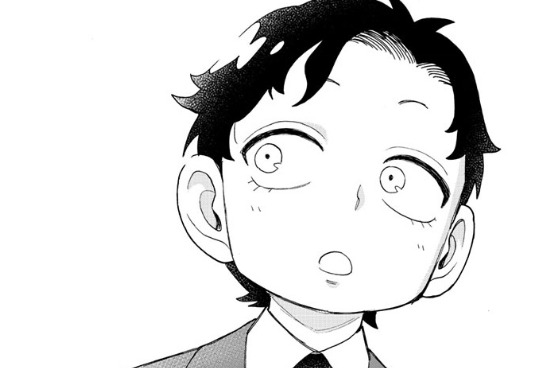
My point: Damian has experienced enough rejection in his childhood that he shouldn't even be trying with his own family anymore. But he does. He keeps trying. Damian still hopes that he can connect with his family, and I think that this is because this is a part of his actual personality.
On the inside, Damian is complex; he struggles with the weight of his identity, he is trying to find his place in the world, he yearns for attention and validation (specifically from his father), he finds comfort in believing that he is better than other people (even his friends), he struggles to handle big emotions, he prefers to work things through independently, and struggles to be vulnerable and ask for help, and he lies to himself about his big feelings so that he can avoid feeling them.
And my favourite thing about him: he still keeps trying. He gathers his courage. He gets back up. Time and time again he feels afraid, and time and time again he feels the fear and he tries anyway.
Damian is so brave, in his own way.
#help i've dissolved into tears#i love my baby boy so much#he really doesn't deserve this#he deserves so much joy#please can someone hug this child#damian desmond#spy x family analysis#spy x family#sxf#spy x family manga#spy x family spoilers#avoidant attachment#attachment theory#attachment
227 notes
·
View notes
Text
Q: How I can detach myself from someone?
Detaching from anything, be that a person, object, or circumstance, means coming back to yourself.
Attachment isn’t a real experience; it is a product of confusion.
Generally it means someone has knowingly or unknowingly assumed something to be permanent that by nature cannot be so.
You aren’t physically bound to this person. The experience of attachment is an occurrence in the mind. It has to do with the mind’s thoughts and the body’s reaction to those thoughts. Or, conversely, the body’s emotions and the mind’s reaction/interpretation regarding those emotions.
When attachment is a force in our life, it is because we have begun to use temporary phenomena as a way to orient and understand who we are and where our happiness resides. It is an indication that we have misattributed some sense of who we are and the joy of that Being to something derivative and external. When that phenomenon’s role in our life changes due to the impermanent nature of this shifting world, it can provoke confusion within us that results in suffering.
Most people “fix” this by going from one attachment to another. Perhaps finding a new boyfriend, pursuing sensory gratification in myriad forms, or fixating on worldly achievement. They play out the same old pattern of delusion but in different ways all while expecting a different result.
I suspect this is why so many of our elders make us sad rather than inspire hope and wisdom—their lives end more with regret than with transformation, peace, and insight.
To discover real peace means loosening this tendency to grasp at the world for happiness and identity, instead turning within to uncover the real meaning of your aliveness when we talk about “life.”
Daily meditation is an essential part of altering your way of living such that you aren’t so much trying to fill a hole within you but rather you are allowing something to come through you into this world. Instead of trying to get happiness from life, you bring happiness to life.
When your way of life becomes an opportunity to express and share the peace and happiness you are finding within, everything changes. There is less fear, more love. Less attachment, more freedom. Less confusion, more peace.
On a more immediate level, try this:
Notice the primary form your attachment takes. It could be thoughts, emotions, or both.
When that attachment begins to express itself, shift your focus from the story you have built in your mind to the feeling of being in your body.
This feeling of inhabiting the body includes both the sensations in the body but also the space in which those sensations occur.
For example, when you feel your hand from the inside out, there is the sensation of the energy-consciousness in your hand but there is the internal spaceless space of awareness in which that sensation presents itself.
By abiding with your attention filling your body in this way, you avoid getting swept up in mental loops of the thoughts that once acted to renew your feelings of pain.
At the same time, it allows the feelings of pain to be there and to be fully experienced without being overcome or swept away by them.
Make this practice persistent so long as you are suffering from the experience of attachment, or really any form of mental anguish. It always subsides into peace, sooner or later.
Lastly, a book I would highly recommend is The Power of Now by Eckhart Tolle.
Namaste :) Much love
144 notes
·
View notes